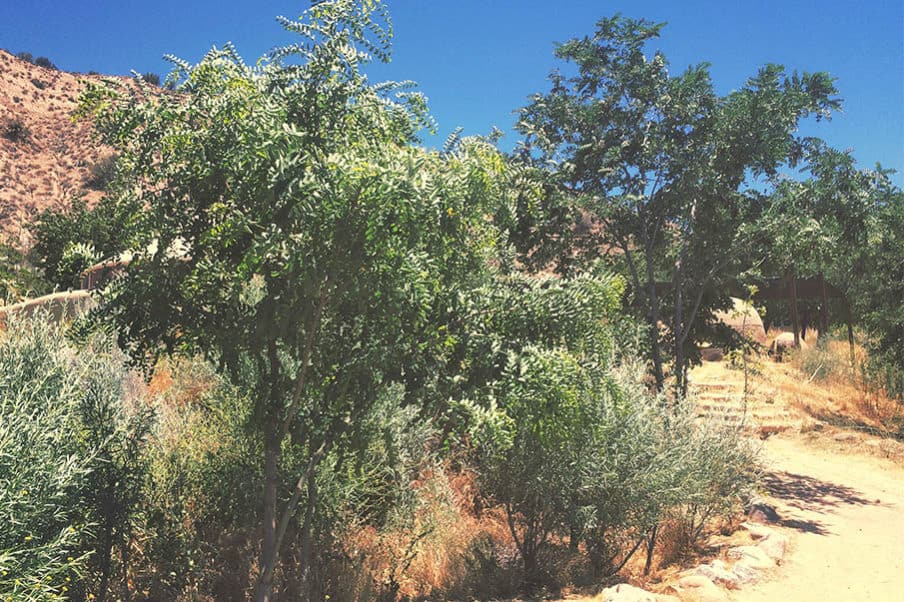Black locust (Robinia pseudoacacia) is a staple tree here at Quail Springs. Native to south-eastern North America, black locust has been naturalized to different temperate climates all around the world due to its many useful functions. Black locust is a fast growing, nitrogen-fixing tree that we have found to be an excellent pioneer species here in our arid climate, due to its extreme adaptability and fast growing nature.
What do we use it for?
Pioneer Species/Garden Shade – Black locust was one of the first trees that was planted on the property for a multitude of reasons. For our pioneer species we were looking for a hardy, drought tolerant plant that was fast growing, provided dappled shade, was nitrogen fixing and would provide food for our animals; we found all of this in the black locust! Rows of black locust were planted in our garden for shade, fodder and nitrogen fixing and planted as companion/pioneer species in our food forest. In our environment we have observed that the black locust can grow 2-8 ft in height a year and new branches after pollarding/coppicing can be between 2-5 ft long by mid-summer; making for an abundant resources!
Fodder & Fuel Wood – When looking for a fodder and fuel wood we knew we wanted to plant something that could coppice or pollard well. After 2-4 years of growth the black locust is a great diameter for fuel wood, fence posts and some of the smaller branches are great for tool handles. We have found that the tree responds better to a low pollard than a full coppice, although all our trees that were coppiced last year came back as well. Throughout the year we cut the smaller branches as fodder for our rabbits, chickens and ducks. The high protein leaves are an absolute favorite among our chickens; they can often be seen jumping and bouncing to reach any low hanging leafs. We try to cut a few small branches every day for the chickens as a healthy supplement to their pellet, compost and forage diet. In the fall before the leaves drop we pollard the trees that are to size and feed the large branches and main stocks to the goats, who strip the bark off for us which allows for a much faster drying process for its next stage of life, our firewood! We have found that most of the black locust have 2-4 main stems and if not they have at least 2 main lead branches. We found that pollarding all but one seems to help the tree to jump back in the spring with many smaller branches, which grow into excellent fodder branches. In addition to our larger 4-legged’s, the bees love the abundant and very sweet smelling blossoms in the spring—excellent bee fodder!
A few words of caution
Although black locust have many benefits there are a few things to keep in mind when considering it for your property. In wetter climates black locust will sucker easily and can drop many seeds, so be sure to plant it in an area where this would not be a problem or alternatively plant it where you will have chickens and they will eat any suckers or sprouts that come up! There are some claims that say that the seeds and leaves are toxic to livestock, we have never found that to be true and most likely these claims have a lot to do with the previous diet and health of your animals. Like any new food, introduce it into their diet slowly and observe for changes in health and behavior. Black locust is toxic to horses and should never be fed to them. Young trees do have thorns on them but these disappear from the main trunk after 2-3 years and are relatively soft on 1st year branch growth
Summary
We are very happy with all the functions that the black locust serve and recommend it as an excellent fodder for poultry, rabbits and bees and a great fuel wood. Without this tree we would have had a hard time establishing our garden; its dappled leaves provided much needed shade in the hot dry summers here. We would also not be able to be feeding so many of our animals from the land without the abundance of our resilient black locusts.



Comments 6
thank you for all the good info on the Black Locust tree. I am wanting to plant them but I do have horses and may consider another plant because of the proximity to horses. Do you know any other tree that isn’t bad for horses that have the wonderful attributes of the Black Locust tree. I appreciate the indepth knowledge shared on your website. Thank you very much Cindy Voss
Good day,
I have heard the leaves have Allelopathic effect on plants? Can the leaves then not be used in compost? And how would it affect nearby trees?
Thanks
I cut some young black locust branches out of the way a few days ago and my chickens leapt on those leaves like they were organic candy. So far nobody is dead. Hope it’s not something that takes a few weeks to show up! If it’s safe, it’s looking like a heck of a treat.
I have about 3 acres of fields in Lubec Maine where I want to establish a perpetual firewood source. Black locust has my intetest.
…Will blacklocust grow this far north for perpetual firewood?
…would stump sprout cutting yield better firewood growth at ground level or 3-4 feet high.
…Any thoughts, thanks…
I have 16 heritage that forage freely on 1/2 acre. They love fresh black locust leaves that blow down after a storm. Perfect size leaf for the gullet.
I have multiple Black Locust Trees on my property in California and the chickens love the leaves and flowers.
Was concerned at first if they could eat them, but haven’t lost any.